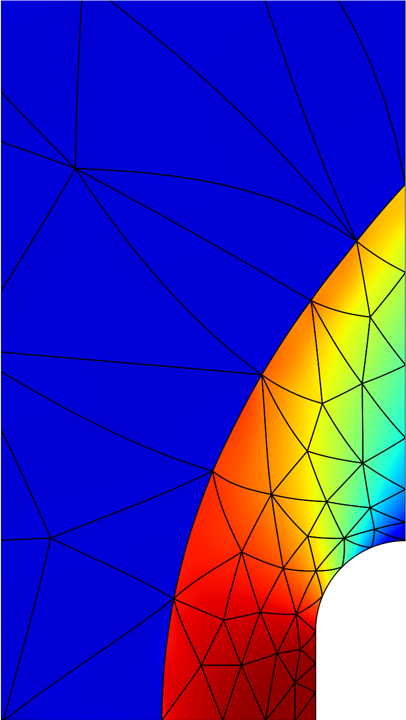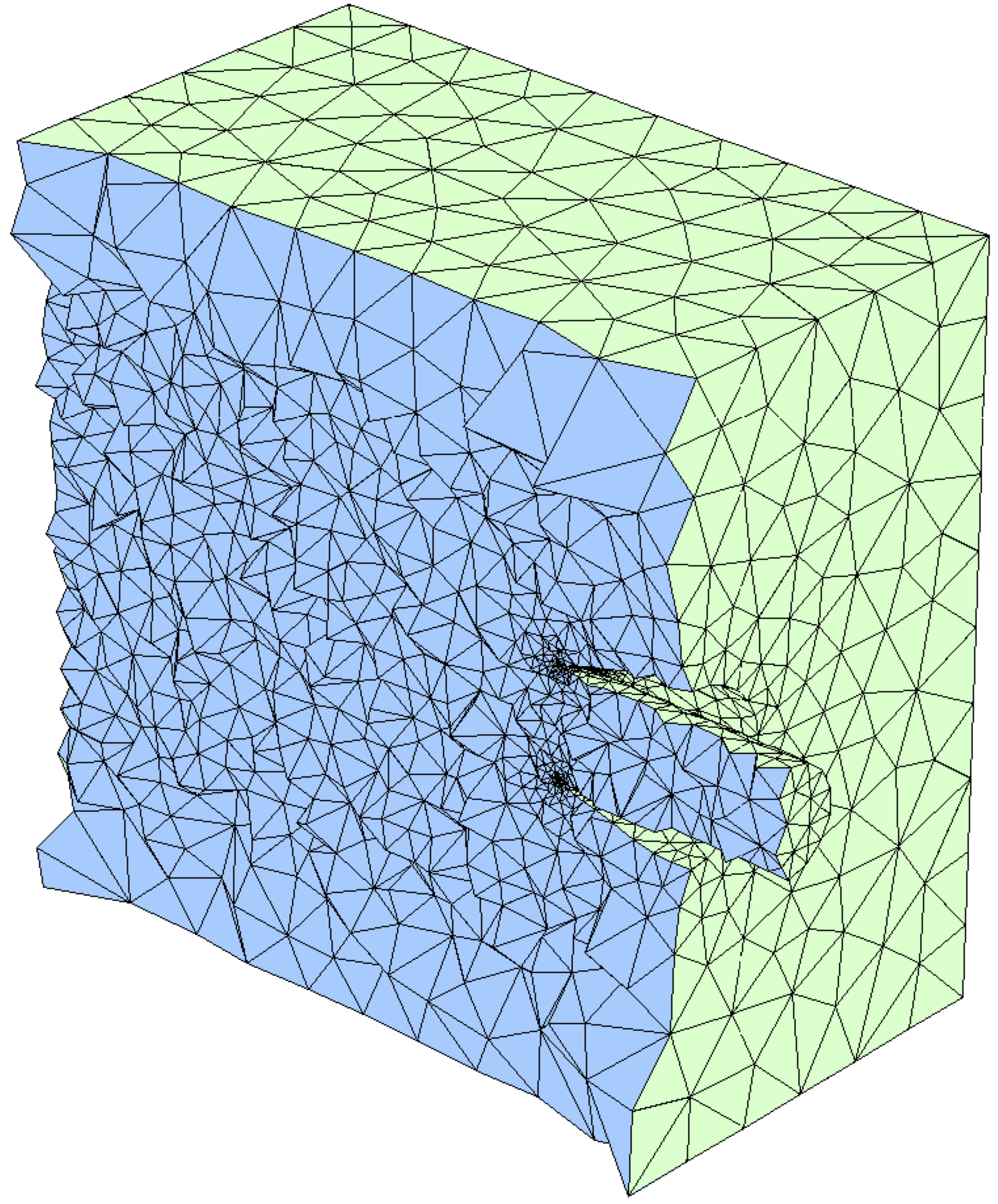
High-order shock tracking
Mathematics Group
Computational Research Division
Lawrence Berkeley National Laboratory
Optimization problems constrained by time-dependent Partial Differential Equations (PDEs) commonly arise in engineering practice, particularly in the context of design or control of physics-based systems. We developed and demonstrated a framework for time-dependent PDE-constrained optimization of conservation laws on deforming domains. High-order methods, in both space (discontinuous Galerkin) and time (Runge-Kutta), are used to compute output functionals to high accuracy. The fully-discrete sensitivity and adjoint equations were derived and implemented, where special attention was required to properly differentiate the Geometric Conservation Law (GCL) treatment. Applications include optimal control and shape optimization of fluid systems governed by the Navier-Stokes equations.
Energetically optimal flapping wing motion under x-thrust constraint (Tx = 0). Left: initial guess for optimization, energy required = 7.23e-1 (nondim), x-thrust = -5.60e-1 (nondim). Right: optimal control, energy required = 1.57 (nondim), x-thrust = 5.01e-8 (nondim).
Optimization under x-force constraint. Left: initial guess for optimization, energy required = 9.41 (nondim), x-thrust = 0.177 (nondim). Center: optimal control, energy required = 4.95 (nondim), x-thrust = 2.50 (nondim). Right: optimal control and time-morphed geometry, energy required = 4.62 (nondim), x-thrust = 2.50 (nondim).
Cyclic steady-state motion of a system, i.e., stable time-periodic behavior, is of central importance in bio-locomotion and many brnches of engineering. Examples includef alpping flight, swimming at low or high Reynolds number, helicopter aerodynamics, turbomachinery, wind turbines, and vehicle tires with treads. In this work, we propose a framework for optimizing partial differential equations using gradient-based method on the manifold of time-periodic solutions. We use a Newton-Krylov shooting method with matrix-free GMRES to determine time-periodic flows. We derived and implemented the adjoint equations and method corresponding to the fully discrete, time-periodically constrained PDE. The adjoint equations are linear, two-point boundary value problems that are provably solvable and we propose a matrix-free GMRES solver, where matrix-vector products are computed with standard adjoint solves.
2D flapping airfoil initialized from steady state (left) and periodic initial condition (right).
This work introduces a fully discrete, high-order numerical framework for solving PDE-constrained optimization problems using gradient-based methods in the case where one or more of the optimization parameters affects the time domain; a canonical example being optimization of the frequency of a flapping wing. In a fully discrete setting, this effective parametrization of the time domain leads to a parametrization of the time discretization, e.g., to maintain a fixed number of timesteps per period, the timestep size is parameter-dependent. Gradients of quantities of interest in this work are computed using the adjoint method, which must take into account the parametric dependence of the time discretization.
Energetically optimal flapping motions for 2D airfoil under thrust constraints Tx = 0 (left), Tx = 1.5 (center), Tx = 2.5 (right) where flapping frequency is one of the optimization parameters.
In collaboration with an MRI research group in Sweden, we have used our time-dependent PDE-constrained optimization methods to superresolved Magnetic Resonsance Images (MRIs). This is a canonical data assimilation problem where we augment our numerical simulations with data to determine inflow appropriate inflow conditions, which is cast as an optimization problem where we minimize the misfit with the data based on a parametrization of the inflow.
Cross-section of MRI data of flow in water tank: low-resolution, noisy space-time velocity measurements.

Computational mesh used for MRI data assimilation (left) and reconstructed high-resolution flow (right).
M. J. Zahr and P.-O. Persson, “Energetically optimal flapping wing motions via adjoint-based optimization and high-order discretizations,” in Frontiers in PDE-Constrained Optimization, Springer, 2017. [ bib | paper ]
M. J. Zahr, P.-O. Persson, and J. Wilkening, “A fully discrete adjoint method for optimization of flow problems on deforming domains with time-periodicity constraints,” Computers & Fluids, 2016. [ bib | DOI | link | arxiv ]
M. J. Zahr and P.-O. Persson, “An adjoint method for a high-order discretization of deforming domain conservation laws for optimization of flow problems,” Journal of Computational Physics, vol. 326, no. Supplement C, pp. 516 -- 543, 2016. [ bib | DOI | link | arxiv ]
J. Wang, M. J. Zahr, and P.-O. Persson, “Energetically optimal flapping flight based on a fully discrete adjoint method with explicit treatment of flapping frequency,” in Proc. of the 23rd AIAA Computational Fluid Dynamics Conference, (Denver, Colorado), American Institute of Aeronautics and Astronautics, 6/5/2017 -- 6/9/2017. [ bib | link | paper ]
M. J. Zahr and P.-O. Persson, “High-order, time-dependent aerodynamic optimization using a discontinuous Galerkin discretization of the Navier-Stokes equations,” in AIAA Science and Technology Forum and Exposition (SciTech 2016), (San Diego, California), 1/4/2016 -- 1/8/2016. [ bib | link | paper ]
M. J. Zahr, “Optimization-based computational physics and high-order methods: from optimized analysis to design and data assimilation,” in LBNL CRD Postdoc Seminar Series, (Berkeley, California), Lawrence Berkeley National Laboratory, 9/18/2017. [ bib | slides ]
M. J. Zahr and P.-O. Persson, “Energetically optimal flapping flight based on a high-order discontinuous Galerkin discretization of the Navier-Stokes equations,” in 23rd AIAA Computational Fluid Dynamics Conference, (Denver, Colorado), 6/5/2017 -- 6/9/2017. [ bib | slides ]
M. J. Zahr, “Gradient-based optimization of flow problems using the adjoint method and high-order numerical discretizations,” in Applied, Computational, and Industrial Math Seminar Series, (San Jose, California), San Jose State University, 5/8/2017. [ bib | slides ]
M. J. Zahr, “Adjoint-based PDE-constrained optimization using globally high-order numerical discretizations,” in 2017 Berkeley/Stanford Computational Mechanics Festival (CompFest), (Berkeley, California), University of California, Berkeley, 5/8/2017. [ bib | slides ]
M. J. Zahr and P.-O. Persson, “Optimization of CFD simulations, with MRI applications,” in TESLA Seminar, (Lunda, Sweden), Lund University, 3/31/2017. [ bib | slides ]
M. J. Zahr and P.-O. Persson, “High-order, time-dependent aerodynamic optimization using a discontinuous Galerkin discretization of the Navier-Stokes equations,” in AIAA Science and Technology Forum and Exposition (SciTech 2016), (San Diego, California), 1/4/2016 -- 1/8/2016. [ bib | slides | paper ]
M. J. Zahr and P.-O. Persson, “High-order methods for optimization and control of conservation laws on deforming domains,” in Dean Seminar at Sandia National Laboratories (Host: Kevin Carlberg), (Livermore, California), 12/14/2015. [ bib | slides ]
M. J. Zahr and P.-O. Persson, “High-order methods for optimization and control of conservation laws on deforming domains,” in Applied Mathematics Seminar at UC Berkeley (Host: Per-Olof Persson), (Berkeley, California), 9/30/2015. [ bib | slides ]
M. J. Zahr, “High-order, time-dependent PDE-constrained optimization using discontinuous Galerkin methods,” in Department of Energy Computational Science Graduate Fellowship Program Review, (Washington D.C.), 7/27/2015 -- 7/30/2015. [ bib | slides ]
M. J. Zahr and P.-O. Persson, “Unsteady CFD optimization using high-order discontinuous Galerkin finite element methods,” in 13th U.S. National Congress on Computational Mechanics (USNCCM13), (San Diego, California), 7/26/2015 -- 7/30/2015. [ bib | slides ]
M. J. Zahr and P.-O. Persson, “Adjoint-based optimization, uncertainty quantification, and data assimilation of multiphysics systems using high-order numerical discretizations,” in DOE ASCR Applied Mathematics PI Meeting, (Washington D.C.), 9/11/2017 -- 9/12/2017. [ bib | poster ]
M. J. Zahr and P.-O. Persson, “Unsteady PDE-constrained optimization using high-order DG-FEM,” in 13th U.S. National Congress on Computational Mechanics (USNCCM13), (San Diego, California), 7/26/2015 -- 7/30/2015. [ bib | poster ]